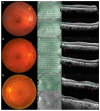The Association of Pachydrusen Characteristics with Choroidal Thickness and Patient's Age in Polypoidal Choroidal Vasculopathy versus Central Serous Chorioretinopathy
- PMID: 35955481
- PMCID: PMC9368714
- DOI: 10.3390/ijms23158353
The Association of Pachydrusen Characteristics with Choroidal Thickness and Patient's Age in Polypoidal Choroidal Vasculopathy versus Central Serous Chorioretinopathy
Abstract
We investigated the relationship between pachydrusen and choroidal thickness and age in eyes with polypoidal choroidal vasculopathy (PCV) and fellow eyes, compared to eyes with central serous chorioretinopathy (CSC). This retrospective study included 89 eyes with PCV and 146 eyes with CSC. The number, location, and shape of the pachydrusen and their association with choroidal thickness and age were analyzed. PCV eyes showed pachydrusen more frequently than eyes with CSC (52% vs. 20%, p < 0.001). Large solitary type and clustered type were more frequent in PCV eyes compared to CSC eyes (p = 0.003 and p = 0.001, respectively). Subfoveal choroidal thickness was associated with pachydrusen in eyes with PCV (odds ratio [OR] 1.006, 95% confidence interval [CI] 1.001−1.011, p = 0.027), while age was associated with pachydrusen in CSC eyes (OR 1.137, 95% CI, 1.073−1.205; p < 0.001). Pachydrusen were localized directly over the pachyvessel on optical coherence tomographic findings in approximately two thirds of PCV eyes and fellow eyes (62% and 67%, respectively). Risk factors for pachydrusen differ according to diseases. The presence of pachydrusen was associated with choroidal thickness in PCV, while the association with age was more prominent in CSC.
Keywords: central serous chorioretinopathy; choroid; pachydrusen; polypoidal choroidal vasculopathy.
Conflict of interest statement
The authors declare no conflict of interest.
Figures



Similar articles
-
Association of Fundus Autofluorescence Abnormalities and Pachydrusen in Central Serous Chorioretinopathy and Polypoidal Choroidal Vasculopathy.J Clin Med. 2022 Sep 11;11(18):5340. doi: 10.3390/jcm11185340. J Clin Med. 2022. PMID: 36142987 Free PMC article.
-
Morphologic features of large choroidal vessel layer: age-related macular degeneration, polypoidal choroidal vasculopathy, and central serous chorioretinopathy.Graefes Arch Clin Exp Ophthalmol. 2018 Dec;256(12):2309-2317. doi: 10.1007/s00417-018-4143-1. Epub 2018 Sep 27. Graefes Arch Clin Exp Ophthalmol. 2018. PMID: 30259090 Review.
-
Pachydrusen in polypoidal choroidal vasculopathy in an Indian cohort.Indian J Ophthalmol. 2019 Jul;67(7):1121-1126. doi: 10.4103/ijo.IJO_1757_18. Indian J Ophthalmol. 2019. PMID: 31238425 Free PMC article.
-
Clinical characteristics of pachydrusen in central serous chorioretinopathy.Graefes Arch Clin Exp Ophthalmol. 2019 Jun;257(6):1127-1132. doi: 10.1007/s00417-019-04284-4. Epub 2019 Mar 9. Graefes Arch Clin Exp Ophthalmol. 2019. PMID: 30852634
-
[Pathophysiology of macular diseases--morphology and function].Nippon Ganka Gakkai Zasshi. 2011 Mar;115(3):238-74; discussion 275. Nippon Ganka Gakkai Zasshi. 2011. PMID: 21476310 Review. Japanese.
Cited by
-
Association of Fundus Autofluorescence Abnormalities and Pachydrusen in Central Serous Chorioretinopathy and Polypoidal Choroidal Vasculopathy.J Clin Med. 2022 Sep 11;11(18):5340. doi: 10.3390/jcm11185340. J Clin Med. 2022. PMID: 36142987 Free PMC article.
-
A Temporal Association between Regression of Pachydrusen and Use of Proprotein Convertase Subtilisin Kexin 9 Inhibitor: A Case Report.Case Rep Ophthalmol. 2024 Aug 8;15(1):614-620. doi: 10.1159/000540014. eCollection 2024 Jan-Dec. Case Rep Ophthalmol. 2024. PMID: 39144648 Free PMC article.
-
Association between Subretinal Drusenoid Deposits and Age-Related Macular Degeneration in Multimodal Retinal Imaging.J Clin Med. 2023 Dec 16;12(24):7728. doi: 10.3390/jcm12247728. J Clin Med. 2023. PMID: 38137797 Free PMC article.
-
Chronic Central Serous Chorioretinopathy in Elderly Subjects: Structure and Blood Flow Characteristics of Retina and Choroid.Ophthalmol Ther. 2024 Jan;13(1):321-335. doi: 10.1007/s40123-023-00849-z. Epub 2023 Nov 15. Ophthalmol Ther. 2024. PMID: 37966697 Free PMC article.
References
MeSH terms
LinkOut - more resources
Full Text Sources
Medical

